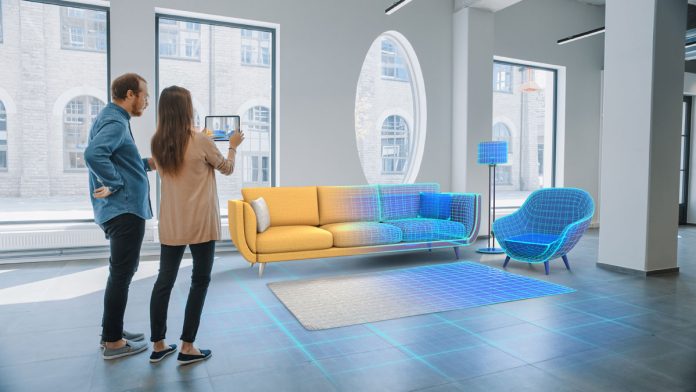To observe furnishing complements in advance, already in their final context. To directly interact with light and space, rigorously reproduced in actual size. To have a 3D preview of any object, stylistic and/or chromatic detail in a room.
These are just some of the possibilities offered by augmented reality, a technology that lends itself to application in décor and design, as explained by Andrea Gurrieri, Chief Marketing Officer of Uqido, a company founded in Padua in 2010 and specialized precisely in software development and artificial intelligence.
First of all, Gurrieri, please explain something to us once and for all: what is the difference between “virtual” reality and “augmented reality”?
The first is typical of video games: the 3D modeling of a possible reality, programmed around the user and perceived with almost all five senses. The second, instead, reproduces the surrounding reality, expanding it and enhancing it with new elements.

One of your clients is IKEA: what have you done for them?
An experience of video mapping inside the store in Padua. With 4K laser projectors, clients had the chance to see an extension of a Bestå bookcase and a Vallentuna sofa projected in the space, in actual size. The graphic interface was very intuitive and suitable for a wide audience: from kids, who enjoy immersion in fantasy settings, to adults who are surprised by the graphic effects of the re-created environments.
And this is just one of the many applications.
Let’s think, for example, about how as clients we have to choose a new armchair for our living room: how large should it be? What color? What type of covering? Usually, in stores they provide a sample, and with that you have to make your decision. But what if it was possible to place all those details in a “real” space, with real lighting? Wouldn’t we be more likely to buy something, and to remember that brand?
In economic terms, is augmented reality an affordable investment for any company?
For very small brands it might be beyond the budget; we start from companies that have at least 300,000 to 400,000 euros in annual sales. But there are other possibilities for smaller players.
Such as?
It is possible to start with the digitalization/virtualization of smaller models, perhaps by constructed a 3D model of a vase, like this one. Or one can start with a sponsored page on Facebook: sharing an image can allow users who click on it to reproduce it in a flash inside their living room.
You do not work only with design.
Augmented reality has infinite applications. We work with companies in the biomedical, electronics, furniture and manufacturing sectors. For Safilo, for example, we have digitalized many eyewear models: just take a camera, and you can see them projected onto your face, to try out the look, without physical contact. The goal, for everyone, is to make life easier for companies and their clients.
What is the most complex aspect of augmented reality when applied to design?
Lighting is undoubtedly one of the most important characteristics of a realistic 3D reconstruction of a setting, and it is the aspect that calls for the most attention. But, after all, who has never had the experience of choosing tile for the bathroom, which in the store seemed bright and perfect, only to see it in their home and realize it was dull and unpleasant in that context? This is precisely one of the experiences that augmented reality can already help to improve.







